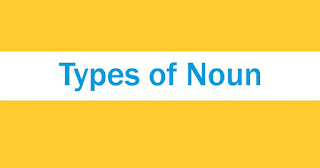Types of Noun in Arabic | Arabic Grammar Concepts
We've learned parts of speech in Arabic. There are three types of word, they are : noun (اسم), verb (فعل), and particle (حرف).
Now, we are going to study more detail about ism or noun in Arabic.
There are several types of noun and we are going to explore them one by one.
===special note===
To get complete understanding about noun, I recommend you to read : What is noun (اسم)? | definition of noun (اسم) in Arabic
===special note===
Types of noun in Arabic
Noun can be divided into six chapters, they are:
1. الاِسْمُ بِالنَّظْرِ إِلَى بُنْيَتِهِ (types of noun in terms of the structure)
It means the noun which is seen from it's final or last letter.
Noun in terms of it's final letter is divided to four, they are:
a. اسم مقصور (ism maqṣuur).
ism maqṣuur is noun which is ended with letter alif , and the letter before alif is fat-hah.
the alif = ا or ي
examples :
مُسْتَشْفًى = hospital
عَصًا = stick
b. اسم منقوص (ism manquuṣ)
ism manquuṣ is noun which is ended with letter ya (ي), and the letter before ya is kasrah.
examples :
القَاضِي = the judge
الرَّاعِي = shepherd; guide; leader
notes:
if you want to write القَاضِي in nakirah (indefinite form), you should write like this -> قَاضٍ
الرَّاعِي in indefinite form -> رَاعٍ
c. اسم ممدود (ism mamduud)
ism mamduud is noun which is ended with hamzah (ء), and the letter before hamzah is alif (ا).
examples :
دَوَاءٌ = medicine
بِنَاءٌ = building; structure
d. اسم صحيح (ism ṣaḥiiḥ)
ism ṣaḥiiḥ is noun other than the nouns mentioned above.
examples :
قَلَمٌ = pen
سَيَّارَةٌ = car
2. الاِسْمُ بِالنَّظْرِ إِلَى نَوْعِهِ (types of noun in terms of gender)
Nouns in terms of gender are divided to two, they are:
a. اسم مذكّر (ism mudhakkar)
ism mudhakkar is masculine noun.
examples :
مُحَمَّدٌ = Muhammad
طَالِبٌ = student
كِتَابٌ = book
b. اسم مؤنّث (ism mu-annath)
ism mu-annath is feminine noun.
examples :
طَالِبَةٌ = female student
مَرْيَمُ = Maryam
سَيَّارَةٌ = car
We will explore more detail the characteristics of feminine noun and masculine noun in the next lesson. in shaa Allah.
Update : the newest lesson about this point => "masculine and feminine noun in Arabic"
3. الاِسْمُ بِالنَّظْرِ إِلَى عَدَدِهِ (types of noun in terms of the quantity/number/amount)
Nouns in terms of quantity are divided to three, they are:
a. اسم مفرد (ism mufrad)
ism mufrad is singular noun.
examples :
كِتَابٌ = a book
سَيَّارَةٌ = a car
b. اسم مثنّى (ism muthanna)
ism muthanna is dual noun.
examples :
كِتَابَانِ = two books
سَيَّارَتَانِ = two cars
c. اسم جمع (ism jam')
ism jam' is plural noun.
examples :
كُتُبٌ = books
سَيَّارَاتٌ = cars
4. الاِسْمُ بِالنَّظْرِ إِلَى تَعْيِيْنِهِ (types of noun in terms of definite or indefinite)
There are two types, they are:
a. اسم النّكرة (ism an-nakirah)
ism an-nakirah is indefinite noun.
examples :
بَيْتٌ = a house
مُدَرِّسٌ = a teacher
b. اسم المعرفة (ism al-ma'rifah)
ism al-ma'rifah is definite noun.
examples :
البَيْتُ = the house
المُدَرِّسُ = the teacher
5. الاِسْمُ بِالنَّظْرِ إِلَى تَغْيِيرِهِ (types of noun in terms of i'rab or cases)
Noun in terms of i'rab (inflection on it's last letter) of a noun comprises:
a. اسم معرب (ism mu'rab)
ism mu'rab is noun which has inflection on it's last letter (the harakat of the last letter can change).
examples:
زَيْدٌ = Zaid
the harakat of the last letter of the word "زَيْدٌ " can changes depends on it's position in a sentence.
- جَلَسَ زَيْدٌ = Zaid sat.
zaid in this sentence is a fa'il (doer). The case of fa'il is nominative case (marfu').
زَيْدٌ = fa'il, marfu' (nominative case), the indication of the rafa' is dammah "u"
- رَأَيْتُ زَيْدًا = I saw zaid.
zaid in this sentence is acted as maf'ul bih (object). The case of maf'ul bih is accusative case (manṣub).
زَيْدًا = object (maf'ul bih), manṣuub (accusative case), the indication of the naṣb is fat-hah "a"
- مَرَرْتُ بِزَيِدٍ = I passed by Zaid
zaid in this sentence comes after harf jar بِ , so the case is genitive case (majrur).
بِ = harf jar
زَيْدٍ = ism majruur, it's majruur by harf jar ب , the indication of the jar is kasrah "i"
We will learn the i'rab (noun inflection) more detail in the next lesson.
b. اسم مبنيّ (ism mabniyy)
ism mabniyy is noun which has no inflection (it has no change at the last letter).
examples :
هَذَا = this
هُوَ = he
We will explore this more comprehensive in the next lesson, in shaa Allah.
6. الاِسْمُ بِالنَّظْرِ إِلَى تَرْكِيبِهِ (types of noun in terms of it's composer / it's derivative or not)
There are two types, they are:
a. اسم جامد (ism jaamid)
ism jaamid is noun which is original (word that is not composed by other words).
examples :
رَجُلٌ = man
قَلَمٌ = pen
b. اسم مشتق (ism mushtaq)
ism mushtaq is noun that is composed by other words (derivative word).
examples :
نَاصِرٌ = helper
نَاصِرٌ is from root verb نَصَرَ
كَاتِبٌ = writer
كَاتِبٌ is from root verb كَتَبَ
Summary of types on nouns in Arabic - video version
OK, now you've understood the types of ism (noun). I'll show you more comprehensive lesson with example in the next posting.
So, stay tuned in this blog.



No comments:
Post a Comment